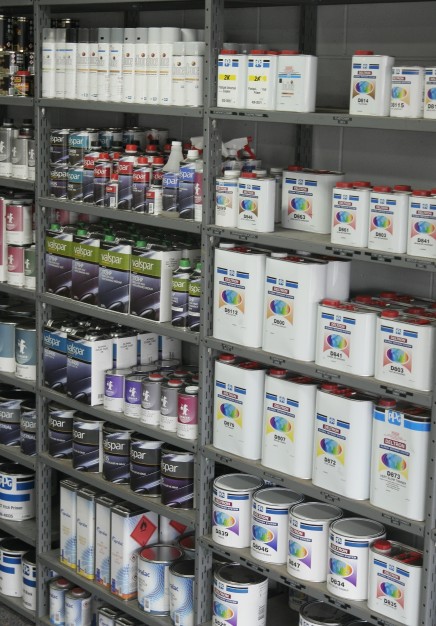
Ever wondered why the factory original colour of the bumper and trim pieces may not match the rest of the vehicle? Well, here are some of the causes of colour variations...
1) A colour can vary depending on the substrate it is painted. For example, the evaporation rate for solven varies over metal or plastic. A longer rate gives a flake pigment additional time to 'float' and can darken the face of the colour.
2) The body was painted on a production line at the factory, while other parts, such as the bumper and trim were painted at another location using a different application method.
3) Slight adjustments can be made during application creating a lighter or darker colour, or causing the metallics or mica elements to lay down differently.
4) Light reflects differently on curved and flat surfaces causing the appearance of a colour shift.




We use the best in colour-matching tools to precisely match factory standards.
Vehicle Cleaning and Maintenance
In order to keep the paintwork in good condition, general road film and atmospheric pollution must not be allowed to accrue. It should be removed at the earliest practicable opportunity.
Automated vehicle washers can be used but care must be exercised with the detergent solutions used. Solutions for automated washers are highly concentrated and dilution ratios of 500:1 are not uncommon and clean water should be used as a final rinse.
Hot pressure cleaners can also be used, but care should be exercised to keep the temperature below 50°C. The lance should not be used closer than 18” from the surface.
Stone chipped panels should be touched in as soon as possible to prevent corrosion creep. The stone chip should be filled with a blob of paint.
Damaged panels or seriously rusted areas that have not been touched in will require thorough sanding and filling before priming and topcoating. We recommend that you follow these simple precautions in the first few months of new paint finishes life.
In the first 30 days
- Do not use a commercial car wash. Stiff brushes or sponges could mar the finish and damage the surface. Wash the vehicle by hand with cool water and a very mild car wash solution. Be sure to use a soft cloth or sponge.
- Wash the vehicle in the shade - never in the sun.
- Do not “dry wipe” the vehicle - always use clean water. Dry wiping could scratch the finish.
- Extreme heat and cold are to be avoided. Keep the vehicle parked in the shade whenever possible.
- Do not drive on gravel roads. Chipping the finish is easily done in the first 30 days.
- Do not park under trees, which drop sap, or near factories with heavy smoke fallout. Sap and industrial fallout mark or spot a freshly painted surface.
- Trees are also likely to attract birds. Bird droppings have a high acid content and will damage a freshly painted surface. Bird droppings should be washed off as soon as possible.
- Do not spill petrol, oil, antifreeze, transmission fluid or wind shield solvent on the new finish. If you do immediately rinse off with water. DO NOT WIPE.
In the first 90 days
Do not use silicone wax or polish the vehicle “ this will allow the finish to dry and harden completely.
After 90 days
Polish then wax paintwork approximately every 3-4 months using micro fibre cloths only.
Soap and Detergents
Molecules of soap and detergents have a ‘water soluble end’ and an ‘organic soluble end’. They are able to attach themselves to non-water soluble fats, oils and waxes and disperse them into solution or into an emulsion. They also lower the surface tension of insoluble dirt particles allowing the water to wet them more effectively.